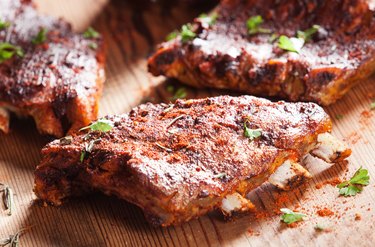
Steaks seem to be one of the more simple cuts of meat, but there are a lot of factors to consider when buying and cooking them. Not least among those considerations are the type of steak and the thickness of the cut. A New York strip steak is always an excellent choice, as it's a top-quality steak with a beautiful balance of flavor, tenderness and marbling. Cutting this pricey steak to an appropriate thickness prior to cooking is necessary for achieving the most delicious results. A too-thin or too-thick New York steak is very difficult to cook to any desired level of doneness no matter how skilled the chef.
What Is New York Steak?
Video of the Day
NY strip steak is also known as Kansas City strip, Omaha strip, ambassador steak, strip loin and boneless strip steak, as it's nearly always sold boneless. These are all just different names for the same cut, which comes from the cow's back, technically the longissimus dorsi muscle. This muscle doesn't see much movement, resulting in a tender steak that retains some bite. New York steaks have a robust beefy flavor and even marbling with no large pockets of fat, making them ideal for grilling without risk of flare-ups. These steaks are also excellent for indoor cooking, whether it's pan frying, pan roasting or broiling.
Video of the Day
The Importance of Thickness
The thickness of a steak is more important than its weight. The best thickness for steak allows for a nice crusty sear on the outside without overcooking the center; this is true for any steak and any desired level of doneness. If a quick-cooking steak, like a boneless strip steak, is cut too thin, it's impossible to achieve a crust on the outside before the center goes beyond well done to overcooked and tough. When the steak is too thick, say over 2 1/2 inches, it's difficult to achieve any particular level of doneness with accuracy. It's also hard to eat a steak that's so thick.
Ideal Thickness for New York Steaks
Culinary experts say the ideal thickness for New York steaks is 1 1/2 to 2 inches. This thickness makes for a sizable steak of up to 1 pound, which can be pricey and too big a portion for most. So, cutting a 1 1/2- to 2-inch NY strip steak into smaller portions, whether by the butcher before purchase or at home before cooking, is generally required.
Do not cut the steak horizontally and ruin that perfect thickness. Instead, cut the steak into smaller pieces across its length or ask the butcher to do so according to your desired portion size. This approach retains the best thickness for the steak and means you don't need to adjust the cooking times for a smaller cut.
NY Steak Thickness and Cooking Times
It's always a good idea to consult a chart in a cookbook or from an expert source online that shows the best interior temperatures and estimated cooking times for a boneless strip steak. Use an instant-read meat thermometer for the most accurate assessment of doneness but remember that the internal temperature will rise by around 5 to 10 degrees after resting.
The interior temperature of a rare New York steak will be in the 120 to 130 degree Fahrenheit range. For medium rare, it's 130 to 140; for medium, 140 to 150; and 160 to 170 for a well-done steak. Pull the steak off the heat when it's 5 to 10 degrees below this, cover it loosely with foil and let it rest for five to 10 minutes before serving. Also follow a guide for cooking times for NY steak for the particular cooking method you're using. These will all be relatively short cooking times with just a single turn of the steak required before it's done.
- What's Cooking America: How To Cook A Perfect Steak
- Serious Eats: Four Expensive Steak Cuts to Know
- Serious Eats: Grilled Strip Steak with Creamy Yogurt Sauce and Tomato-Cucumber Salad | The Food Lab Turbo
- Omaha Steaks: Omaha Steaks Cooking Chart
- Omaha Steaks: The Butcher’s Guide: What is a New York Strip?